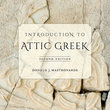 Accentuation Tutorial
Accentuation Tutorial

|
TOPICS Accent and Accent-Marking in Ancient Greek The Last 3 Syllables and the Accents Persistent Accentuation |
In the consonant declension, where the different cases may vary in their number of syllables, accentuation needs to be considered in terms of the syllables of the word-stem rather than simply in terms of A, P, and U. The accent tends to persist on the same syllable of the stem as in the “main form.” The changes in position and type of accent that are seen in other forms depend on the length of the ultima and on a few other rules specific to the consonant declension (complications caused by contraction are not covered here). (4) for words of the consonant declension with monosyllabic stems, the accent falls on P or the only syllable in the nominative, accusative, and vocative, but on U of the genitive and dative of all numbers (acute on short vowels, circumflex on long). (For the contrast between genitive/dative and the other cases, compare rule 1.) (5) adjectives of the consonant declension that have a separate feminine with short alpha declension always have the circumflex on U in the genitive plural feminine (compare rule 3 for a-declension nouns). (6) (same as rule 2) a long accented P followed by short U must have a circumflex (this is a general rule applying to all Greek forms). Examples are shown on the next two screens. |
||||